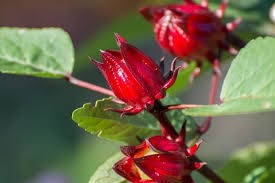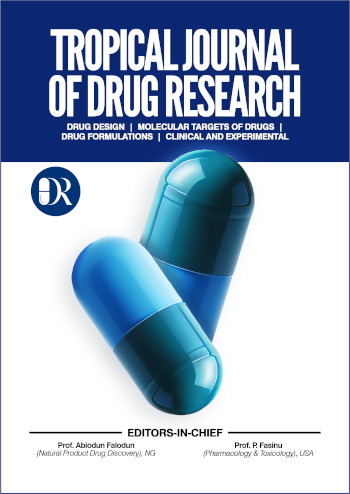Public Health implications of the microbiological analysis of Zobo (Hibiscus sabdariffa) drink produced and hawked in Eket, South-South Nigeria
DOI:
https://doi.org/10.26538/tjdr.vol2no9.72Keywords:
Zobo drink, Public Health implications, Microbiological analysis, Bacteria, FungiAbstract
Purpose: Zobo drink is a local, cheaper soft drink made from Hibiscus sabdariffa calyx, which is an herbaceous medicinal plant grown in the tropics. The study was designed to assess the Public Health implications of the microbiological analysis of Zobo (Hibiscus sabdariffa) drink produced and hawked in Eket, South-South Nigeria.
Methods: Hawked Zobo drinks packaged in plastic bottles were purchased from ten different hawkers at different locations. Nutrient Agar (NA), MacConkey Agar (MCA), Salmonella Shigella Agar (SSA) and Sabouraud Dextrose Agar (SDA) were used for analysis of bacteria and fungi. Different microscopic and biochemical tests were employed to further identify the bacterial and fungal isolates.
Results: The bacteria isolated from the samples analyzed include Staphylococcus aureus, Salmonella spp, Pseudomonas spp., Escherichia coli, Streptococcus spp., Campylobacter spp., Lactobacillus spp., and Klebsiella spp., with the highest percentage of occurrence being S. aureus. The total bacterial count ranged from 2.6 to 6.6 x103 cfu/ml in Nutrient agar, 1.0 to 2.5 x 103 cfu/ml in MacConkey agar and 2.4 to 7.3 x 103 cfu/ml in Salmonella-shigella agar. The fungi isolated from the samples were yeast (Saccharomyces cerevisiae), Aspergillus sp, Fusarium sp, Penicillium sp and Rhizopus sp., with a total count ranging from 5.4 to 9.1 x 104 cfu/ml in Sabouraud dextrose agar.
Conclusion: As Pubic Health implication, the likely sources of contamination of the zobo drinks analyzed are from the handlers, equipment and utensils used for processing, the water source and the method of dispensing into nylon or plastic bottles.
Downloads
References
1. Oboh G, Elusiyan CA. Nutrient composition and antimicrobial properties of sorrel drinks (Zoborodo). J Med Food Sc. 2004; 7:340-342.
2. Bryan FL, Tuefel P, Riaz S, Qadar F, Malik Z. Hazards and critical control points of vending operations at a railway station and a bus station in Pakistan. J Food Protect. 1992; 55:334-541.
3. Ashefani M. Bacteriological profile and holding temperature of ready-to-serve food items in an open market in Awassa, Ethiopia. Trop Geogr Med. 1995; 47:1-4.
4. WHO. The role of food safety in health and development: Report of a joint FAO/WHO export committee on food safety. Technical Report Series. 1984; 705.
5. Egbere OJ, Anuonye JC, Chollum PF, Okpara PV. Effects of preservation technique on the quality and storage stability of Zobo drink (a Nigerian non-alcoholic beverage from Hibiscus sabdariffa). J Food Technol. 2007; 5 (3): 225-228.
6. Olayemi F, Adedayo R, Muhummad R, Bamishaiye E. The nutritional quality of three varieties of Zobo (H. sabdariffa) subjected to the same preparation condition. Am. J. Food Tech. 2011; 6:705-708.
7. Jay JM. Modern Food Microbiology 4th Ed. CBS Publishers, New Delhi 1996; p. 701.
8. Olukoya DK, Bakare B, Abayomi O. Microbiological evaluation of food samples sold to Primary School Children in Lagos State, Nigeria. J Trop Paed. 1991; 37:266-269.
9. Mensah P, Yeboah MD, Owusu DK, Ablordey A. Street foods in Accra, Ghana: How safe are they? Bulletin of the World Health Organization, 2002; 80(7): 547-554.
10. Pelczar MJ, Chan ECS, Noel RKC. Microbiology (5th ed.) Tata McGraw Hill, New Delhi 2005; p. 571.
11. Olasupo NA, Smith SI, Akinsinde KA. Examination of the Microbial Status of Selected Indigenous Fermented Foods in Nigeria. J Food Safety. 2002; 22:85-93.
12. Raimi OR. Bacteriology quality of Zobo drinks consumed in some parts of Osun State, Nigeria. J Appl Sci Environ Manage. 2013; 17(1):113-117.
13. Omole U, Oranusi S, Ahuekwe EF, Ayomikun KA. The Physiochemical and Microbiological Characteristics of Fermented Hibiscus sabdariffa Calyxes Using Probiotics Starter Cultures. Trop J Nat Prod Res. 2022; 6(4):580-586. doi.org/10.26538/tjnpr/v6i4.19
14. Shetty HP, Sharma D, Bhat GK. Manual of practical microbiology. CBS Publishers & Distributors Pvt. Ltd; 2022.
15. Chowdhury A. Manual of medical microbiology. New Central Book Agency; 2016.
16. Holt JG, Krieg NR, Sneath PHA, Staley JT, Williams ST. Bergey’s manual of determinative bacteriology (9th ed.). Williams & Wilkins; 1994.
17. Moon HJ, Kwak YJ, Jang SW, Yim S. Antioxidant activity and correlation analysis of phenolic compounds in novel varieties of Lactuca sativa L. Trop J Pharm Res. 2025; 24(5):575-582. https://dx.doi.org/10.4314/tjpr.v24i5.1
18. Iwetan BB, Kweki GR, Onobrudu DAO, Ugochukwu U, Andy OO, Ewhre LO, Obianime AW. Hepatorenal protection of Justicia carnea leaf aqueous extract on sheep red blood cell-induced immunotoxicity in mice. Trop J Pharm Res. 2025; 24(5):667-676. https://dx.doi.org/10.4314/tjpr.v24i5.5

Downloads
Published
Issue
Section
License

This work is licensed under a Creative Commons Attribution-NonCommercial-ShareAlike 4.0 International License.




